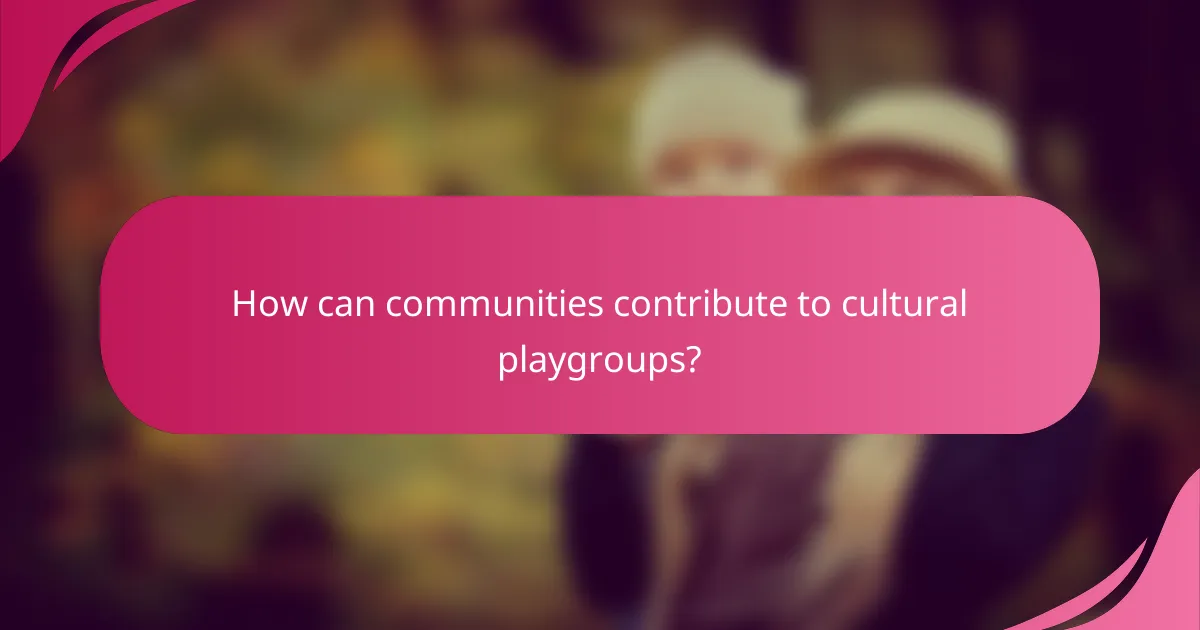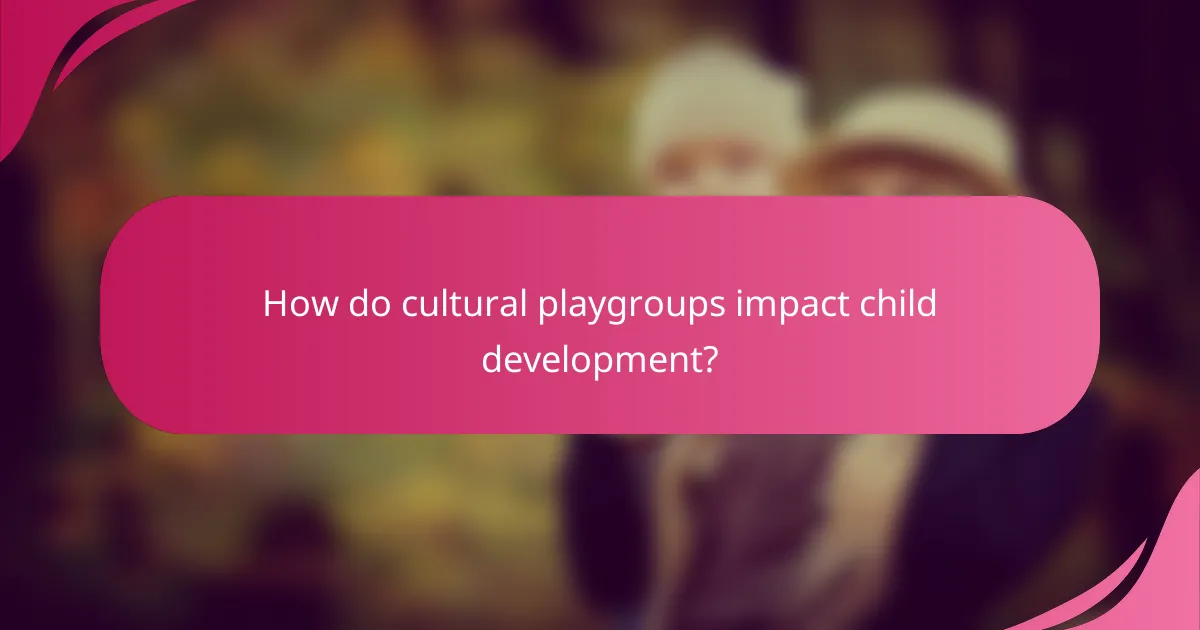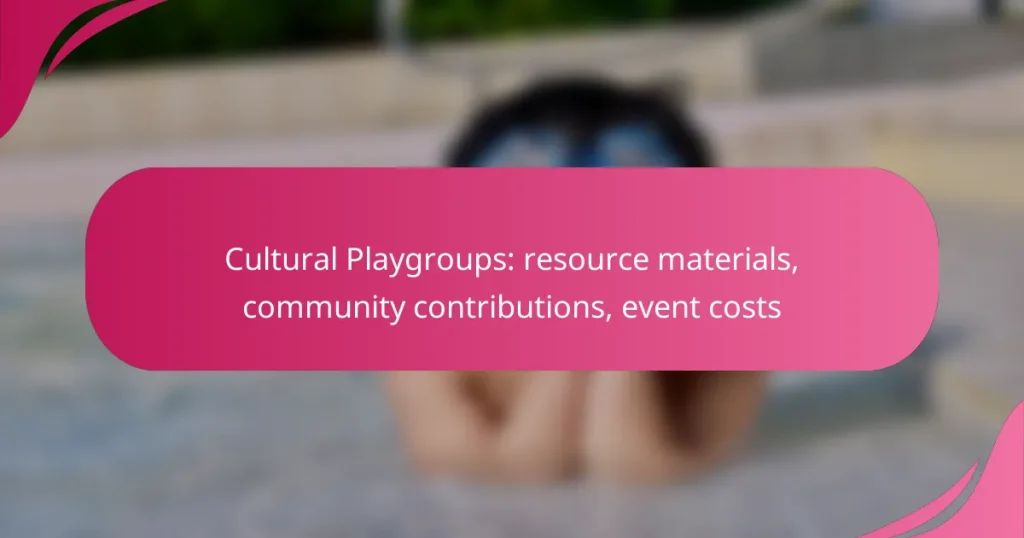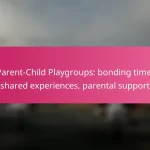Cultural playgroups benefit from a wealth of resources, such as educational materials and support from local organizations, which enhance the experience for both facilitators and participants. Community contributions, including volunteering and donations, play a crucial role in enriching these programs and promoting cultural exchange. However, it’s important to consider the varying costs associated with events, which can include venue rentals, supplies, and promotional expenses.

What resources are available for cultural playgroups?
Cultural playgroups can access a variety of resources to enhance their programs, including educational books, online toolkits, community centers, and local organizations. These resources provide valuable information and support for facilitators and participants alike.
Books on cultural education
Books focused on cultural education offer insights into diverse traditions, practices, and developmental strategies. Titles may cover topics such as multicultural teaching methods, child development in various cultural contexts, and activities that promote cultural awareness.
Consider selecting books that are age-appropriate and relevant to the specific cultures represented in your playgroup. Look for resources that include practical activities, stories, and illustrations to engage children effectively.
Online toolkits for facilitators
Online toolkits provide facilitators with structured resources, including lesson plans, activity guides, and assessment tools tailored to cultural education. These toolkits often include downloadable materials and multimedia resources that enhance learning experiences.
Utilize these toolkits to streamline your planning process. Many platforms offer customizable options that allow you to adapt the content to fit the unique needs of your playgroup.
Community resource centers
Community resource centers serve as hubs for local cultural playgroups, offering access to materials, workshops, and networking opportunities. These centers often provide space for events and activities, as well as connections to local experts in cultural education.
Check with your local community center to find out about available resources, including grants or funding opportunities that can help offset event costs. Engaging with these centers can also foster partnerships with other organizations.
Local cultural organizations
Local cultural organizations play a crucial role in supporting cultural playgroups by providing expertise, resources, and programming. They may offer workshops, performances, and events that enrich the cultural experience for children and families.
Reach out to these organizations to explore collaboration opportunities. Many organizations are eager to partner with playgroups to promote cultural understanding and may offer free or low-cost resources to assist in your programming efforts.

How can communities contribute to cultural playgroups?
Communities can enhance cultural playgroups through various contributions, including volunteering, donating materials, and hosting events. These efforts not only enrich the playgroup experience but also foster a sense of belonging and cultural exchange among families.
Volunteer opportunities
Volunteering is a vital way for community members to support cultural playgroups. Individuals can assist with organizing activities, supervising children, or leading cultural workshops. Engaging in these roles helps create a vibrant environment where children can learn and explore diverse cultures.
To get involved, check local community boards or social media groups for announcements about volunteer needs. Many playgroups appreciate help on a flexible basis, allowing volunteers to contribute as their schedules permit.
Donations of materials
Donating materials is another significant way to support cultural playgroups. This can include books, art supplies, musical instruments, or cultural artifacts that reflect the community’s diversity. Such contributions enrich the playgroup’s resources and provide children with hands-on learning experiences.
Before donating, consider reaching out to the playgroup coordinators to understand their specific needs. This ensures that your contributions are useful and appreciated, enhancing the overall experience for the children involved.
Hosting events
Hosting events is an effective way to engage the community and promote cultural playgroups. These events can range from cultural festivals to educational workshops, providing opportunities for families to connect and learn from one another. Organizing such gatherings can strengthen community ties and celebrate cultural diversity.
When planning an event, consider factors such as location, budget, and target audience. Collaborating with local businesses or cultural organizations can also help reduce costs and increase participation, making the event more successful and impactful.

What are the costs associated with cultural playgroup events?
The costs associated with cultural playgroup events can vary widely based on location, size, and specific activities planned. Key expenses typically include venue rental fees, materials and supplies, and marketing and promotion costs.
Venue rental fees
Venue rental fees can be a significant portion of the overall budget for cultural playgroup events. Depending on the location, these fees can range from low tens of USD for community centers to several hundred USD for larger or more prestigious venues.
When selecting a venue, consider factors such as accessibility, capacity, and available amenities. Booking in advance may also help secure better rates or discounts.
Materials and supplies costs
Materials and supplies costs encompass everything needed for activities, such as art supplies, educational materials, and snacks. These expenses can vary, but budgeting around 5-15 USD per participant is a reasonable estimate for most events.
To minimize costs, consider sourcing materials through donations or local businesses. Collaborating with community members can also lead to shared resources and reduced expenses.
Marketing and promotion expenses
Marketing and promotion expenses are essential for attracting participants to cultural playgroup events. Costs can include flyers, social media ads, and local newspaper listings, typically ranging from 50 to 200 USD depending on the methods used.
Utilizing free platforms like social media and community bulletin boards can significantly reduce marketing costs. Engaging local influencers or community leaders to spread the word can also enhance visibility without incurring high expenses.

What are the benefits of joining a cultural playgroup?
Joining a cultural playgroup offers numerous advantages, including enhanced cultural awareness, social networking opportunities, and support for diverse communities. These groups provide a platform for families to engage with various cultural practices and foster connections with others who share similar interests.
Enhanced cultural awareness
Participating in a cultural playgroup helps individuals and families gain a deeper understanding of different cultures. Activities often include storytelling, traditional games, and cooking sessions that celebrate various cultural heritages.
By exposing children and parents to diverse customs and languages, playgroups promote appreciation and respect for cultural differences. This awareness can lead to more inclusive attitudes and behaviors in everyday life.
Social networking opportunities
Cultural playgroups serve as excellent venues for building social connections. Parents can meet others in their community, share experiences, and create lasting friendships while their children engage in fun activities.
These networks can also facilitate information exchange about local resources, events, and support systems, enhancing the overall community experience. Regular gatherings help strengthen these bonds and create a sense of belonging.
Support for diverse communities
Cultural playgroups play a crucial role in supporting diverse communities by providing a safe space for families to express their cultural identities. They often collaborate with local organizations to offer resources and assistance tailored to specific community needs.
In addition, these groups can advocate for cultural representation and inclusion within broader community initiatives, ensuring that diverse voices are heard and valued. This support fosters a more cohesive and understanding environment for everyone involved.

What criteria should be considered when selecting a cultural playgroup?
When selecting a cultural playgroup, consider factors such as location accessibility, program offerings, and facilitator qualifications. These elements significantly impact the overall experience and effectiveness of the playgroup in fostering cultural engagement and community connection.
Location accessibility
Location accessibility is crucial for ensuring that families can easily attend the playgroup. Look for venues that are centrally located and have good public transport links or ample parking options. Additionally, consider whether the space is child-friendly and equipped for families with strollers or mobility challenges.
Evaluate the surrounding environment as well; safe neighborhoods and nearby amenities can enhance the overall experience. If possible, choose a location that is familiar to the community, as this can encourage participation and comfort among families.
Program offerings
The program offerings of a cultural playgroup should align with the interests and needs of the community it serves. Look for playgroups that provide a variety of activities, such as storytelling, arts and crafts, music, and cultural celebrations. These diverse offerings can help children engage with different aspects of their heritage while promoting social interaction.
Consider the frequency and duration of the sessions as well. Regular, shorter sessions may be more appealing to families compared to infrequent, longer gatherings. Ensure that the activities are age-appropriate and cater to a range of developmental stages to maximize participation.
Facilitator qualifications
Facilitator qualifications are essential for creating a safe and enriching environment in a cultural playgroup. Look for individuals who have experience working with children and a strong understanding of the cultural elements being presented. Qualifications in early childhood education or related fields can be beneficial.
Additionally, assess the facilitator’s ability to engage with families and create a welcoming atmosphere. Strong communication skills and cultural sensitivity are vital for fostering trust and encouraging participation among diverse groups. Consider asking for references or testimonials from previous participants to gauge effectiveness.

How do cultural playgroups impact child development?
Cultural playgroups significantly enhance child development by fostering social skills, emotional intelligence, and cultural awareness. These environments encourage children to interact with peers from diverse backgrounds, promoting inclusivity and understanding from an early age.
Resource materials
Resource materials for cultural playgroups include books, games, and activities that reflect various cultures. These materials can help children learn about different traditions, languages, and customs, enriching their understanding of the world. Consider sourcing bilingual books or culturally themed toys that engage children while teaching them about diversity.
Community contributions
Community contributions play a vital role in the success of cultural playgroups. Local families can share their traditions through storytelling, cooking demonstrations, or cultural performances, creating an immersive experience for children. Engaging parents and community members fosters a sense of belonging and encourages collaboration, enhancing the playgroup’s impact.
Event costs
Event costs for cultural playgroups can vary widely based on location and activities. Budgeting for materials, venue rental, and refreshments is essential. Many community centers offer affordable spaces, and local businesses may sponsor events, helping to keep costs manageable. Aim for a budget that allows for quality experiences without financial strain, typically ranging from a few dozen to a couple hundred dollars per event.


